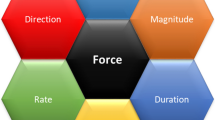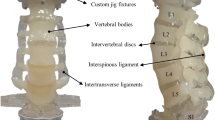Abstract
We investigated the synthesis of electrical stimulation patterns for functional movement restoration in human paralyzed limbs. We considered the knee joint system, co-activated by the stimulated quadriceps and hamstring muscles. This synthesis is based on optimized functional electrical stimulation (FES) patterns to minimize muscular energy consumption and movement efficiency criteria. This two-part work includes a multi-scale physiological muscle model, based on Huxley’s formulation. In the simulation, three synthesis strategies were investigated and compared in terms of muscular energy consumption and co-contraction levels. In the experimental validation, the synthesized FES patterns were carried out on the quadriceps-knee joint system of four complete spinal cord injured subjects. Surface stimulation was applied to all subjects, except for one FES-implanted subject who received neural stimulation. In each experimental validation, the model was adapted to the subject through a parameter identification procedure. Simulation results were successful and showed high co-contraction levels when reference trajectories were tracked. Experimental validation results were encouraging, as the desired and measured trajectories showed good agreement, with an 8.4 % rms error in a subject without substantial time-varying behavior. We updated the maximal isometric force in the model to account for time-varying behavior, which improved the average rms errors from 31.4 to 13.9 % for all subjects.






Similar content being viewed by others
References
Benoussaad M, Poignet P, Guiraud D (2007) Optimal patterns synthesis approach for knee motion under functional electrical stimulation. In: 12th Annual Conference of the International FES Society, Philadelphia, PA, USA
Benoussaad M, Poignet P, Guiraud D (2008) Optimal functional electrical stimulation patterns synthesis for knee joint control. In: Intelligent robots and systems, 2008. IROS 2008. IEEE/RSJ International Conference on Nice, pp 2386–2391. doi:10.1109/IROS.2008.4651112
Benoussaad M, Poignet P, Hayashibe M, Azevedo-Coste C, Fattal C, Guiraud D (2013) Experimental parameter identification of a multi-scale musculoskeletal model controlled by electrical stimulation: application to patients with spinal cord injury. Med Biol Eng Comput 51:617–31. doi:10.1007/s11517-013-1032-y
Chae J, Kilgore K, Triolo R, Creasey G, DiMarco A (2004) Functional neuromuscular stimulation. In: DeLisa J, Gans D (eds) Rehabilitation medicine: principles and practice, 4th edn. J. B. Lippincott Company, Philadelphia, pp 1405–1425
Chang GC, Luh JJ, Liao GD, Lai JS, Cheng CK, Kuo BL, Kuo TS (1997) A Neuro-control system for the knee joint position control with quadriceps stimulation. IEEE Trans Rehabil Eng 5:2–11
Chizeck H, Kobetic R, Marsolais EB, Abbas JJ, Donner IH, Simon E (1988) Control of functional neuromuscular stimulation systems for standing and locomotion in paraplegics. Proc IEEE 76:1155–1165
Dariush B, Parnianpour M, Hemami H (1998) Stability and a control strategy of a multilink musculoskeletal model with applications in FES. IEEE Trans Biomed Eng 45:3–14
El Makssoud H, Guiraud D, Poignet P, Hayashibe M, Wieber PB, Yoshida K, Azevedo-Coste C (2011) Multiscale modeling of skeletal muscle properties and experimental validations in isometric conditions. Biol Cybern 105:121–138. doi:10.1007/s00422-011-0445-7
Ferrarin M, Palazzo F, Riener R, Quintern J (2001) Model-based control of FES-induced single joint movements. IEEE Trans Rehabil Eng 9:245–257
Franken DHM, Veltink PPH, Tijsmans IR, Nijmeijer DH, Boom PHBK (1993) Identification of passive knee joint and shank dynamics in paraplegics using quadriceps stimulation. IEEE Trans Rehabil Eng 1:154–164
Guiraud D, Stieglitz T, Koch KP, Divoux JL, Rabischong P (2006) An implantable neuroprosthesis for standing and walking in paraplegia: 5-year patient follow-up. J Neural Eng 3:268–275
Hatze H (1978) A general myocybernetic control model of skeletal muscle. Biol Cybern 157:143–157
Hatze H (1981) Myocybernetic control models of skeletal muscle. University of South Africa, South Africa
Hawkins D, Hull M (1990) A method for determining lower extremity muscle-tendon lengths during flexion/extension movements. J Biomech 23:487–494
Hill AV (1938) The heat of shortening and the dynamic constants of muscle. R Soc Lond Proc Ser B 126:136–195
Hogan N (1984) Adaptive control of mechanical impedance by coactivation of antagonist muscles. IEEE Trans Automat Contr 29:681–690
Huxley AF (1957) Muscle structure and theories of contraction. Prog Biophys Biophys Chem 7:255–318
Khalil W, Dombre E (2004) Trajectory generation. In: Khalil W, Dombre E (eds) Modeling, identification and control of robots. Butterworth-Heinemann, Oxford, pp 313–345
Kobetic R, Marsolais B (1994) Synthesis of paraplegic gait with multichannel functional neuromuscular stimulation. IEEE Trans Rehabil Eng 2:66–79
Levy M, Mizrahi J, Susak Z (1990) Recruitment, force and fatigue characteristics of quadriceps muscles of paraplegics isometrically activated by surface functional electrical stimulation. J Biomed Eng 12:150–156. doi:10.1016/0141-5425(90)90136-B
Lin DC, Rymer WZ (1991) A quantitative analysis of pendular motion of the lower leg in spastic human subjects. IEEE Trans Biomed Eng 38:906–918. doi:10.1109/10.83611
McNeal D, Nakai R, Meadows P, Tu W (1989) Open-loop control of the freely-swinging paralyzed leg. IEEE Trans Biomed Eng 36:895–905
Migliore SA, Brown EA, DeWeerth SP (2005) Biologically inspired joint stiffness control. In: Proceedings of the 2005 IEEE international conference on robotics and automation, pp 4508–4513. doi:10.1109/ROBOT.2005.1570814
Popović D, Stein RB, Oguztöreli MN, Lebiedowska M, Jonić S (1999) Optimal control of walking with functional electrical stimulation: a computer simulation study. IEEE Trans Rehabil Eng 7:69–79
Riener R, Fuhr T (1998) Patient-driven control of FES-supported standing up: a simulation study. IEEE Trans Rehabil Eng 6:113–124
Riener R, Quintern J, Psaier E, Schmidt G (1996) Physiological based multi-input model of muscle activation. Neuroprosthetics 12:95–114
Stein RB, Zehr EP, Lebiedowska MK, Popović DB, Scheiner A, Chizeck HJ (1996) Estimating mechanical parameters of leg segments in individuals with and without physical disabilities. IEEE Trans Rehabil Eng 4:201–211
Veltink PH, Chizeck HJ, Crago PE, El-Bialy A (1992) Nonlinear joint angle control for artificially stimulated muscle. IEEE Trans Biomed Eng 39:368–380. doi:10.1109/10.126609
Winters JM (1990) Hill-based muscle models: a systems engineering perspective. In: Winters JM, Woo SY (eds) Chapter 5 Multiple muscle systems: biomechanics and movement organization, New York: Springer, pp 69–93
Zhou BH, Katz SR, Baratta RV, Solomonow M, D’Ambrosia RD (1997) Evaluation of antagonist coactivation strategies elicited from electrically stimulated muscles under load-moving conditions. IEEE Trans Biomed Eng 44:620–633
Acknowledgments
The authors would like to thank the patients for their participation and patience, and also Maria Papaiordanidou, Robin Passama and Patrick Benoit for their help during the experiments.
Author information
Authors and Affiliations
Corresponding author
Rights and permissions
About this article
Cite this article
Benoussaad, M., Poignet, P., Hayashibe, M. et al. Synthesis of optimal electrical stimulation patterns for functional motion restoration: applied to spinal cord-injured patients. Med Biol Eng Comput 53, 227–240 (2015). https://doi.org/10.1007/s11517-014-1227-x
Received:
Accepted:
Published:
Issue Date:
DOI: https://doi.org/10.1007/s11517-014-1227-x




